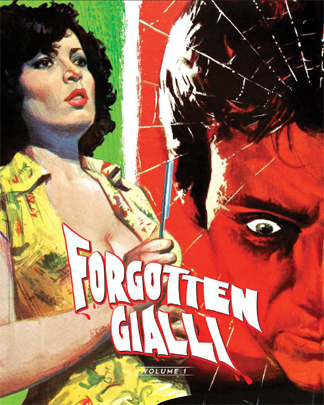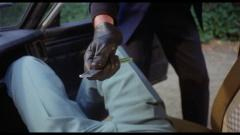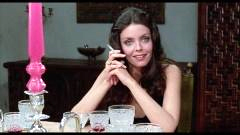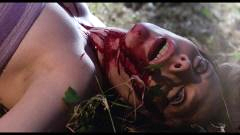 FORGOTTEN
GIALLI – VOLUME 1: TRAUMA (1977)/THE KILLER IS ONE OF 13 (1973)/THE
POLICE ARE BLUNDERING IN THE DARK (1973) Blu-ray
FORGOTTEN
GIALLI – VOLUME 1: TRAUMA (1977)/THE KILLER IS ONE OF 13 (1973)/THE
POLICE ARE BLUNDERING IN THE DARK (1973) Blu-rayDirector(s): León Klimovsky, Javier Aguirre, Helia Colombo
Vinegar Syndrome
 FORGOTTEN
GIALLI – VOLUME 1: TRAUMA (1977)/THE KILLER IS ONE OF 13 (1973)/THE
POLICE ARE BLUNDERING IN THE DARK (1973) Blu-ray
FORGOTTEN
GIALLI – VOLUME 1: TRAUMA (1977)/THE KILLER IS ONE OF 13 (1973)/THE
POLICE ARE BLUNDERING IN THE DARK (1973) Blu-rayVinegar Syndrome takes on the giallo genre in a roundabout way with a trio of rare oddities in the FORGOTTEN GIALLI: VOLUME 1 limited edition Blu-ray boxed set.
The word giallo is Italian for yellow and associated with a series of post-war pulp paperbacks with sometimes outrageously violent and misleading covers – several of the originals being reprints of the works of Agatha Christie, John Dickson Carr, Dashiel Hammet, and others before future Italian screenwriters like Ernesto Gastaldi started penning short stories and serialized mysteries for magazines – with the early examples of the Italian film variation as much inspired by the fascist-era "white telephone movies" and the German Edgar Wallace krimi films, including Mario Bava's THE GIRL WHO KNEW TOO MUCH, "The Telephone" segment of BLACK SABBATH, and BLOOD AND BLACK LACE before the late sixties "jet-setting-woman-in-peril" trends of the late sixties of Umberto Lenzi and the more familiar body count/slasher-antecedent take popularized by Dario Argento and Sergio Martino. While the giallo really did not take off in English-speaking countries as a genre – apart from stylistic homages by the likes of Brian De Palma and John Carpenter – the genre was popular in other European territories. While a number of Italian/Spanish co-productions are well-known to giallo fans in their Italian and export versions featuring the trademark sex and violence that would have been censored in Franco-era Spain, the solely Spanish takes on the genre were less exported than the country's horror entries with lower budgets and often not headlined by internationally recognizable stars apart from a couple like León Klimovsky's A DRAGONFLY FOR EACH CORPSE which headlined Paul Naschy. Vinegar Syndrome's set includes two examples of the Spanish giallo: one from the Franco period and another from the post-Franco period of "S" classification, almost-anything-goes exploitation.

The latter is León Klimovsky's TRAUMA in which novelist Daniel (THE DRACULA SAGA's Heinrich Starhemberg, billed as "Henry Gregor") finds seclusion at a lakeside inn run by Veronica (Ágata Lys, THE DEADLY TRIANGLE), a neurotic beauty who looks after her paraplegic husband sequestered in the attic. Daniel sends Veronica mixed messages, at times seeming to try to counter her self-defeating attitude and other times seeming to be attracted to her. Both his creativity and her opportunities to be alone with him are frustrated not only by her husband calling her away to sexually degrade her (offscreen) but also by the arrival of unwelcome guests: starting with horny hiking couple Victor (Antonio Mayans, MACUMBA SEXUAL) and Ana (Irene Foster, EL SACERDOTE) who mysteriously vanish without paying the next morning, followed by businessman Gabriel (Ricardo Merino, THE OTHER BEDROOM) and hooker Eva (Isabel Pisano, THE LAST HOUSE ON THE BEACH) when their car breaks down nearby, and then Daniel's worried wife Elena (Sandra Alberti, DEATH HAUNTS MONICA). As someone starts slashing their way through the cast with a razor, it is not hard to pick out the killer from Sandra's husband (Aparicio Rivero, WHO CAN KILL A CHILD?) who seems to otherwise exist solely in tinted flashbacks, sexually-frustrated Veronica, creatively-blocked (and possibly sexually-dysfunctional) Daniel, or the young boy (Tony García Jr.) who likes to peep on Veronica from the woods.
 As
much a proto-slasher as a PSYCHO-knockoff, TRAUMA – not to be confused
with late period Gianni Martucci's body count giallo TRHAUMA (1980) –
is no real mystery; indeed, it is best enjoyed as a study in sexual frustration
and dysfunction. If Veronica's crippled husband really is dead and she is not
nuts, then she seems to be able to only achieve sexual release by degrading
herself. Daniel is never seen writing, and a couple flashbacks suggest sexual
impotence which may explain why he draws away from Veronica as soon as he interests
her. It is no surprise that the victims are of the have sex and die variety.
The nudity is equal opportunity with Mayans an old hand in Jess Franco's films
of the period and the subsequent decade, Merino (who also served as production
manager) running around in and out of hilarious patterned briefs, and even Starhemberg
baring all for his art at a most unflattering angle. The film's cast and crew
include veterans of Paul Naschy films including director Klimovsky, composer
Angel Arteaga (FRANKENSTEIN'S BLOODY TERROR), and cast members Starhemberg (who
appeared as a party guest in DR. JEKYLL AND THE WEREWOLF and also worked behind
the scenes on THE DEVIL'S POSSESSED) and Merino who both appeared in Klimovsky's
A DRAGONFLY FOR EACH CORPSE and INQUISITION. Screenwriter Carlos Puerto –
who also scripted Naschy's EL FRANCOTIRADOR – would helm the sexy occult
film SATAN'S BLOOD with actress Alberti the same year.
As
much a proto-slasher as a PSYCHO-knockoff, TRAUMA – not to be confused
with late period Gianni Martucci's body count giallo TRHAUMA (1980) –
is no real mystery; indeed, it is best enjoyed as a study in sexual frustration
and dysfunction. If Veronica's crippled husband really is dead and she is not
nuts, then she seems to be able to only achieve sexual release by degrading
herself. Daniel is never seen writing, and a couple flashbacks suggest sexual
impotence which may explain why he draws away from Veronica as soon as he interests
her. It is no surprise that the victims are of the have sex and die variety.
The nudity is equal opportunity with Mayans an old hand in Jess Franco's films
of the period and the subsequent decade, Merino (who also served as production
manager) running around in and out of hilarious patterned briefs, and even Starhemberg
baring all for his art at a most unflattering angle. The film's cast and crew
include veterans of Paul Naschy films including director Klimovsky, composer
Angel Arteaga (FRANKENSTEIN'S BLOODY TERROR), and cast members Starhemberg (who
appeared as a party guest in DR. JEKYLL AND THE WEREWOLF and also worked behind
the scenes on THE DEVIL'S POSSESSED) and Merino who both appeared in Klimovsky's
A DRAGONFLY FOR EACH CORPSE and INQUISITION. Screenwriter Carlos Puerto –
who also scripted Naschy's EL FRANCOTIRADOR – would helm the sexy occult
film SATAN'S BLOOD with actress Alberti the same year.

It appears that THE KILLER IS ONE OF 13 when widowed Lisa Mandel (Patty Shepard, THE WITCHES MOUNTAIN) invites a number of her husband's friends and associates – womanizing sportsman Harry Stephen (Simón Andreu, THE BLOOD-SPATTERED BRIDE), abstract artist Arlen (Jack Taylor, EL CONDE DRACULA), vulgar nouveau riche cannery owner Jorge (Alberto Fernández, THE LAST KAMIKAZEE) and his socially-concerned wife (Paloma Cela, A TOWN CALLED HELL), violent Guillermo Gil (Eduardo Calvo, THE BLUE EYES OF THE BROKEN DOLL) and his younger wife Laura (future Almadovar muse Carmen Maura, MATADOR), bookish Martin (José María Prada, LEONOR) and his wife Sylvia (May Heatherly, PIECES), suspected gold-digger Miss Hoven (Dyanik Zurakowska, THE SWEET SOUND OF DEATH), engaged Cecilia (Doris Coll, A WITCH WITHOUT A BROOM) whose first marriage is shrouded in mystery, as well as Lisa's late husband's domineering aunt Bertha (Trini Alonso, POLVOS MAGICOS) and her perverted son Francis (Eusebio Poncela, ARREBATO) – to a weekend party at a mansion in the middle of nowhere in order to accuse one of them of her husband's murder. With the chauffeur Ernest (Paul Naschy, CURSE OF THE DEVIL) stealing away with maid Emilia (Rosa de Alba, THE DEVIL'S KISS) after dark, Lisa can only depend on handsome butler Henry (Ramiro Oliveros, CROSS OF THE DEVIL) to spy and provide her with dirt on the suspects because it's so gauche to suspect the butler when someone starts narrowing down the list of suspects by murdering those who may actually know the killer's identity.
 A
giallo patterned after the Agatha Christie-esque country house party murder
mysteries like TEN LITTLE INDIANS, THE KILLER IS ONE OF 13 is incredibly tame
when it comes to violence and sex despite suggesting a number of perversions
among the characters – one almost feels sorry for Francis when it seems
as if he is a closeted homosexual spying more on Naschy's beefy chauffeur than
the maid (what with memories of Poncela as the sympathetic gay character in
Eloy de la Iglesia's CANNIBAL MAN) until it turns out he is an upper-class creep
who preys on women "below his station" from the maid to Zurakowska's
houseguest who must admit to working as a waitress because her wealthy industrialist
father is also a miser – with the first murder not occurring until over
an hour into the film; indeed, it plays less like the covered version of an
exportable Spanish genre pic than one designed specifically for what the Spanish
censors imagine of a domestic Spanish audience. The plot as far as such murder
mysteries go is entirely conventional – livened only by the cast of Eurocult
familiars and the murders when and only when accomplished cinematographer Francisco
Fraille (LET SLEEPING CORPSES LIE) gets creative with the camerawork –
including such creaky conventions as characters whose secrets are less scandalous
than simply looked down upon by British society of the earlier half of the century.
The only real source of suspense is whether the film actually will throw in
the final plot twist one has suspected or if the filmmakers will be entirely
satisfied with the more contrived resolution. Director Javier Aguirre shows
little of the flare of his Naschy ventures HUNCHBACK OF THE MORGUE and COUNT
DRACULA'S GREAT LOVE, and Naschy gets a prominent billing has only a few minutes
of screen time.
A
giallo patterned after the Agatha Christie-esque country house party murder
mysteries like TEN LITTLE INDIANS, THE KILLER IS ONE OF 13 is incredibly tame
when it comes to violence and sex despite suggesting a number of perversions
among the characters – one almost feels sorry for Francis when it seems
as if he is a closeted homosexual spying more on Naschy's beefy chauffeur than
the maid (what with memories of Poncela as the sympathetic gay character in
Eloy de la Iglesia's CANNIBAL MAN) until it turns out he is an upper-class creep
who preys on women "below his station" from the maid to Zurakowska's
houseguest who must admit to working as a waitress because her wealthy industrialist
father is also a miser – with the first murder not occurring until over
an hour into the film; indeed, it plays less like the covered version of an
exportable Spanish genre pic than one designed specifically for what the Spanish
censors imagine of a domestic Spanish audience. The plot as far as such murder
mysteries go is entirely conventional – livened only by the cast of Eurocult
familiars and the murders when and only when accomplished cinematographer Francisco
Fraille (LET SLEEPING CORPSES LIE) gets creative with the camerawork –
including such creaky conventions as characters whose secrets are less scandalous
than simply looked down upon by British society of the earlier half of the century.
The only real source of suspense is whether the film actually will throw in
the final plot twist one has suspected or if the filmmakers will be entirely
satisfied with the more contrived resolution. Director Javier Aguirre shows
little of the flare of his Naschy ventures HUNCHBACK OF THE MORGUE and COUNT
DRACULA'S GREAT LOVE, and Naschy gets a prominent billing has only a few minutes
of screen time.

Apparently, THE POLICE ARE BLUNDERING IN THE DARK since four young photographic models have vanished on a stretch of road to Rome after visiting the Villa Eleonora to pose for wheelchair-bound Edmond, the husband of Eleonora (Halina Zalewska, THE LONG HAIR OF DEATH) who seems less interested in her than her pretty niece Sara (Elena Veronese, SCENT OF A WOMAN). When model Enrichetta (Margaret Rose Keil, THE BIG BUST-OUT) vanishes after being forced to spend the night in a village pensione, boyfriend journalist Giorgio D'Amato (Joseph Arkim) gets himself invited to the villa where he learns that Sara is as much afraid of her aunt as her uncle – who she claims has invented a device capable of photographing human thought – throwing herself at Giorgio seemingly not of her own volition. Giorgio learns something of the dysfunction of the couple's marriage from family friend Dr. Dalia who appears to have feelings for Eleonora that may be coloring his dire diagnosis for Edmond who insists that there is nothing wrong with him. Also lurking the corridors is valet Alberto who may have some mysterious hold over the household, or at least on nymphomaniac housemaid Lucia (Gabriella Giorgelli, SEVEN BLOODSTAINED ORCHIDS).
 The
only Italian giallo in the set is one of the least-seen and most certainly the
runt of the litter in spite of an interesting sci-fi conceit that goes "underdeveloped."
Once believed to be a Turkish/Italian co-production – "Joseph Arkim"
is not Turkish exploitation star Cüneyt Arkin (LION MAN) and director "Helia
Colombo" is only partially a pseudonym – THE POLICE AER BLUNDERING
IN THE DARK was made in 1973 in which the villa décor could only charitably
be called outdated "pop art" and the same could be said of the cast
members and their oddball makeup and wardrobe choices (from the photographer's
afro and ascot combo to Zelewska's rat's nest hairstyle to Veronese's ill-fitting
Carnaby Street fashions). The pacing is sluggish, the direction clunky, the
photography functional, with only the scoring of Aldo Saitto intermittently
effective when it calls to mind Sante Maria Romitelli's HATCHET FOR THE HONEYMOON
score. In terms of imagination, production value, and general clunkiness, the
film is probably on the same tier as lesser gialli like the aforementioned TRHAUMA,
NAKED GIRL KILLED IN THE PARK, or CIAK SI MUORE!
The
only Italian giallo in the set is one of the least-seen and most certainly the
runt of the litter in spite of an interesting sci-fi conceit that goes "underdeveloped."
Once believed to be a Turkish/Italian co-production – "Joseph Arkim"
is not Turkish exploitation star Cüneyt Arkin (LION MAN) and director "Helia
Colombo" is only partially a pseudonym – THE POLICE AER BLUNDERING
IN THE DARK was made in 1973 in which the villa décor could only charitably
be called outdated "pop art" and the same could be said of the cast
members and their oddball makeup and wardrobe choices (from the photographer's
afro and ascot combo to Zelewska's rat's nest hairstyle to Veronese's ill-fitting
Carnaby Street fashions). The pacing is sluggish, the direction clunky, the
photography functional, with only the scoring of Aldo Saitto intermittently
effective when it calls to mind Sante Maria Romitelli's HATCHET FOR THE HONEYMOON
score. In terms of imagination, production value, and general clunkiness, the
film is probably on the same tier as lesser gialli like the aforementioned TRHAUMA,
NAKED GIRL KILLED IN THE PARK, or CIAK SI MUORE!

While companies doing Blu-ray upgrades of more esteemed gialli are usually criticized for reissuing the same films rather than previously-unreleased ones, no one could accuse Vinegar Syndrome of that with the FORGOTTEN GIALLI set. TRAUMA has only been available on a Spanish DVD featuring a non-anamorphic letterboxed transfer and no English audio options. While this source found its way stateside as a fansub, Vinegar Syndrome's 1080p24 MPEG-4 AVC 1.85:1 widescreen Blu-ray from a 2K scan of the original camera negative is a better way to experience the film. The sunny lakeside settings and white-walled interiors of the inn now look more moodily lit and composed, aiding the film's attempts to wring menace out of mundane settings. Some jitteriness in a few shots turns out to be a shaky handheld camera and possibly a bum tripod mount since cutaway shots in the same scene are rock solid. The make-up effects gags hold up well with the enhanced resolution while the score and post-dubbed soundtrack are well-served by the DTS-HD Master Audio 2.0 mono track (a Dolby Digital 2.0 track is also included). Optional English subtitles are free of any obvious errors.
THE KILLER IS ONE OF 13 was also previously only issued on Spanish DVD and accessible as a fansub. Vinegar Syndrome's 1080p24 MPEG-4 AVC 1.85:1 widescreen Blu-ray, also from a 2K scan of the original camera negative, does what it can with a bland-looking film, bringing out textures in the seventies clothing and hair as well as offering up for inspection some prosthetic make-up effects while a couple shots cleared of video haze now look like Bava homages. The Spanish DTS-HD Master Audio 2.0 mono of this talky film delivers clear dialogue while the stings of Alfonso Santisteban's otherwise uninspired score spring out of largely hiss-free silences. Optional English subtitles are included.

THE POLICE ARE BLUNDERING IN THE DARK was long available only in a fansub of a Super 8 print that was as soft and grainy as expected, so Vinegar Syndrome's 1080p24 MPEG-4 AVC 1.85:1 widescreen Blu-ray – again from a 2K scan of the negative – is a giant step up from before and a revelation of a minor degree of polish previously unsuspected from the earlier example. While one would not credit the filmmakers with a color scheme, the bits of saturated color in the wardrobe, bloodshed, and décor do pop from the alternately bland and rustic settings. The enhanced resolution gives a sense of glamor to the male and female leads, enhances the ruddy complexions of the village locals, but does not always flatter cast members including the actor who plays Dr. Dalia who looks like an albino with a bad tan and Zalewska who looks sickly under the flat lighting and pancake make-up. The Super 8 version placed the film's final shot with the Italian epigraph just after the opening credits. One is not sure whether this was intended. It is a comic coda at the end or a bewildering clue at the start. There does seem to be a digital dissolve on the Blu-ray from end of the title sequence which holds longer than it seems it should and the subsequent shot down the road. The DTS-HD Master Audio Italian 2.0 mono track is in good condition, rendering the post-dubbed dialogue in all its awkward delivery – what the hell kind of name is "Enrichetta Blond" and why does everyone draw out utterances of it so – while the optional English subtitles call the valet both Roberto and Alberto.
 Extras
are sparse in this set but Vinegar Syndrome does try to give the films and the
genre some context. TRAUMA features an audio commentary by film historian Troy
Howarth who notes the film's shortcomings, compares the film's main theme to
a Goblin track but suggests that the lesser quality of the other score cues
is due to journeyman director Klimovsky usually having nothing to do with the
post-production on his films, pontificates on the motivations of producer/star
Starhemberg, and relays some of the better credits of the cast and crew. The
disc also includes a photo slideshow (0:30). THE KILLER IS ONE OF 13 is accompanied
by an audio commentary with author/critic Kat Ellinger who notes that the film
is indeed a giallo but not in the post-Argento mold, and that the prominent
billing of Naschy may have geared up audiences for something more violent and
sexy – Spanish distributor Belen Films also released the more conventionally
horrific THE HANGING WOMAN as well as two of Amando de Ossorio's Blind Dead
films – while the poor domestic reception and little scholarship on the
film is due as much to Spanish critical attitudes to genre product in the 1970s.
The disc also includes a photo slideshow (1:15). THE POLICE ARE BLUNDERING IN
THE DARK does not feature a commentary but an audio essay by historian/critic
Rachael Nisbet (15:53) who reveals that the film was finished in 1973 under
the artsier title IL GIARDINO DELLE LATTUGHE which provides a clue to the denouement
but changed to the current politziotteschi-sounding title for its 1975 release.
She reveals that director Helia Columbo was actually a TV and film composer
– presumably also the brother or father of Giuseppe Colombo who briefly
appears as Lucia's boyfriend but would later become a producer for Cine 2000,
backing Dario Argento's THE STENDHAL SYNDROME, PHANTOM OF THE OPERA, and THE
WAX MASK, along with some of Tinto Brass' nineties and post-2000 works –
and that his inexperience is the likely explanation for the film's admitted
shortcomings. She also notes that the film was Zalewska's last appearance before
her early death in an apartment fire. A photo slideshow (0:24) is also included.
The three discs are housed in an appropriately garishly designed hard cardboard
box while the cases themselves do not have reversible covers (understandable
given how little artwork exists for all three of these films).
(Eric Cotenas)
Extras
are sparse in this set but Vinegar Syndrome does try to give the films and the
genre some context. TRAUMA features an audio commentary by film historian Troy
Howarth who notes the film's shortcomings, compares the film's main theme to
a Goblin track but suggests that the lesser quality of the other score cues
is due to journeyman director Klimovsky usually having nothing to do with the
post-production on his films, pontificates on the motivations of producer/star
Starhemberg, and relays some of the better credits of the cast and crew. The
disc also includes a photo slideshow (0:30). THE KILLER IS ONE OF 13 is accompanied
by an audio commentary with author/critic Kat Ellinger who notes that the film
is indeed a giallo but not in the post-Argento mold, and that the prominent
billing of Naschy may have geared up audiences for something more violent and
sexy – Spanish distributor Belen Films also released the more conventionally
horrific THE HANGING WOMAN as well as two of Amando de Ossorio's Blind Dead
films – while the poor domestic reception and little scholarship on the
film is due as much to Spanish critical attitudes to genre product in the 1970s.
The disc also includes a photo slideshow (1:15). THE POLICE ARE BLUNDERING IN
THE DARK does not feature a commentary but an audio essay by historian/critic
Rachael Nisbet (15:53) who reveals that the film was finished in 1973 under
the artsier title IL GIARDINO DELLE LATTUGHE which provides a clue to the denouement
but changed to the current politziotteschi-sounding title for its 1975 release.
She reveals that director Helia Columbo was actually a TV and film composer
– presumably also the brother or father of Giuseppe Colombo who briefly
appears as Lucia's boyfriend but would later become a producer for Cine 2000,
backing Dario Argento's THE STENDHAL SYNDROME, PHANTOM OF THE OPERA, and THE
WAX MASK, along with some of Tinto Brass' nineties and post-2000 works –
and that his inexperience is the likely explanation for the film's admitted
shortcomings. She also notes that the film was Zalewska's last appearance before
her early death in an apartment fire. A photo slideshow (0:24) is also included.
The three discs are housed in an appropriately garishly designed hard cardboard
box while the cases themselves do not have reversible covers (understandable
given how little artwork exists for all three of these films).
(Eric Cotenas)